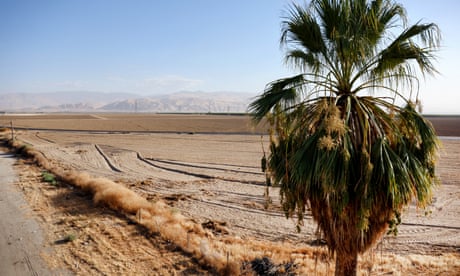- by foxnews
- 09 Mar 2025
‘It took everything’: the disease that can be contracted by breathing California’s air
‘It took everything’: the disease that can be contracted by breathing California’s air
- by theguardian
- 30 Aug 2022
- in news

The illness that would change Rob Purdie's life started with a headache, a terrible pain that began around New Year's 2012 and stayed for months.
It was only after several trips to urgent care facilities, multiple doctors and incorrect diagnoses - everything from sinus infections to cluster headaches - he learned what was wrong with him.
The Bakersfield, California, resident had meningitis caused by Valley fever, a disease that comes from Coccidioides, a fungus endemic to the soil of the US south-west. Years of debilitating illness, struggles finding effective treatments and other hardships followed.
"It took everything - my health," Purdie said. "It had a huge impact on my family. We lost everything, all our financial security, all our retirement."
The father of two is among the small percentage of people who develop serious forms of Valley fever - most people don't get sick after exposure and very few have severe symptoms. But for those who develop the chronic form of the disease, it can be devastating.
Valley fever is increasing in California's Central Valley, as it has for years, and experts say that in the future cases could rise across the American west as the climate crisis renders the landscape drier and hotter.
Kern county, located just north of Los Angeles at the end of the Central Valley, has reported a substantial increase over the last decade. The county, where Purdie lives, documented about 1,000 cases in 2014. In 2021, there were more than 3,000 cases, according to public health data.
Testing and awareness of Valley fever has improved in recent years, and at the same time the county has grown, leading to more cases. But there has also been a significant growth in the illness, said Dr Royce Johnson, the medical director of the Valley Fever Institute in Bakersfield.
"There's enormously more Valley fever now. I can tell that just from the work," Johnson said. "We think most of that has to do with climate and weather."
The fungus that causes Valley fever needs hot and dry conditions to survive, which the US south-west provides, said Morgan Gorris, an earth system scientist at Los Alamos National Laboratory who has studied the relationship between climate crisis and Valley fever, or coccidioidomycosis.
"Much of the western US is very dry already. When we look at projections of climate change it's expected that the western half of the US will continue to remain pretty dry and that's going to continue to support Valley fever," said Gorris.
The fungus grows in the dirt as a filament, Johnson said, that segments and breaks off and becomes airborne when disturbed, traveling as far as 75 miles - it has even infected sea otters. People can become exposed to Valley fever by digging in undisturbed soil or simply by breathing.
People who work outdoors are thought to be at greater risk. Last summer, seven firefighters who responded to fires around the Tehachapi mountains, south-east of Bakersfield, experienced respiratory illness. Three were diagnosed with Valley fever, according to an article published by the CDC.
About 40% of people develop a respiratory illness that can be very mild, according to Johnson, and 1% have more severe outcomes. Most people won't become ill after exposure to the fungus, and of those who do, experts estimate very few actually receive a Valley fever diagnosis.
In the US, primarily in Arizona and California, there were roughly 20,000 cases of Valley fever reported to the CDC in 2019 and an average of about 200 associated deaths each year from 1999 to 2019, according to the most recent data available.
Research authored by Gorris and others has shown that the climate crisis could expand the areas in which Valley fever is found. In a high greenhouse gas emissions climate warming scenario, the area endemic to Valley fever expanded farther north, reaching the US-Canadian border by 2100, Gorris said of the research.
Under a more moderate scenario with less warming and fewer emissions, there is less northward expansion of the disease, she said.
"Mitigating climate change could mitigate the health effects of Valley fever," she said. "It's important to understand that it's not just doom and gloom."
In California, as the climate shifts to more intense periods of rainfall and then subsequent dry seasons, conditions in which Valley fever thrives, there could be more cases, she added.
Purdie became sick after such a period, a wet year followed by dry weather, he recalls. At the time, he lived on a few acres on the outskirts of Bakersfield where he frequently spent time outdoors.
Valley fever threw his life into disarray. Purdie, who was then a financial planner, struggled to work and had to sell treasured family mementoes to support his family as he sought to get a hold on the illness.
He was eventually able to find the right treatment, which requires four pills a day and medication administered directly into his brain every 16 weeks. It's a difficult treatment that causes him severe vomiting, sometimes to the point of nearly passing out. Purdie sometimes struggles to interact with people and carry on conversations.
But he's become an advocate for Valley fever awareness and has been able to resume working again. He works for the Valley Fever Institute as a patient and program development coordinator.
"I have a really severe form of Valley fever," he said. "The disease can be very terrifying and very debilitating. But I don't want people to be afraid of it. I want people to be aware of it."
- by foxnews
- descember 09, 2016
'Speaker scum' on flights sparks debate among travelers: 'This is getting out of hand'
A traveler asked social media users to weigh in on flyers who play audio aloud on their devices and don't use headphones.
read more


